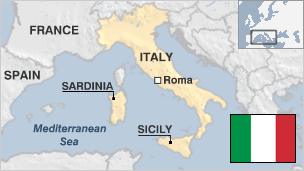Italy profile - Overview
-
Published

Take the art works of Botticelli, Leonardo da Vinci, Michelangelo, Tintoretto and Caravaggio, the operas of Verdi and Puccini, the cinema of Federico Fellini, add the architecture of Venice, Florence and Rome and you have just a fraction of Italy's treasures from over the centuries.
While the country is renowned for these and other delights, it is also notorious for its precarious political life and has had several dozen governments since the end of World War II.
The Italian political landscape underwent a seismic shift in the early 1990s when the "mani pulite" ("clean hands") operation exposed corruption at the highest levels of politics and big business. Several former prime ministers were implicated and thousands of businessmen and politicians were investigated.
There were high hopes at the time that the "mani pulite" scandal would give rise to a radical reform of Italian political culture, but these hopes were dashed when the old structures were replaced by a new political landscape dominated by the multi-millionaire businessman Silvio Berlusconi, who himself became increasingly mired in scandals and corruption affairs.
The growing popularity since 2009 of a protest movement led by the comedian and activist Beppe Grillo reflects the level of discontent with all the mainstream parties, which many Italians see as being irredeemably self-serving and out of touch with the concerns of ordinary citizens.
Italy was one of the six countries that signed the 1951 Paris Treaty setting Europe off on the path to integration. It has been staunchly at the heart of Europe ever since, although the government led by Mr Berlusconi in the early 2000s adopted a more Eurosceptic stance.
Mr Berlusconi sought to align Italy more closely to the US, breaking ranks with the country's traditional allies, France and Germany, in his support for the US-led campaign in Iraq.
Italy is the fourth largest European economy and for long enjoyed one of the highest per capita incomes in Europe, despite the decline in traditional industries such as textiles and car manufacturing as a result of globalisation.
But it became one of the first eurozone victims of the global financial crisis of 2008. By mid-2012, Italy had the second-highest level of public debt - a towering 123% of GDP (annual economic output) - in the eurozone.
There is concern over Italy's birth rate - one of the lowest in Europe - and the economic implications of an ageing population.